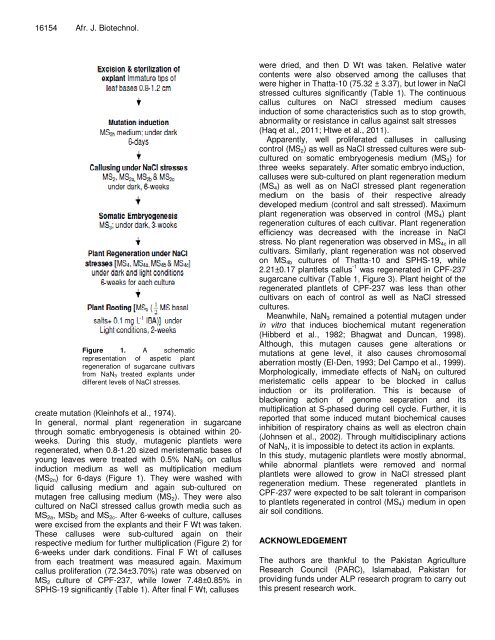(L.) C. Jeffrey from India using internal transcribed - Academic ...
(L.) C. Jeffrey from India using internal transcribed - Academic ...
(L.) C. Jeffrey from India using internal transcribed - Academic ...
Create successful ePaper yourself
Turn your PDF publications into a flip-book with our unique Google optimized e-Paper software.
16154 Afr. J. Biotechnol.<br />
Figure 1. A schematic<br />
representation of aspetic plant<br />
regeneration of sugarcane cultivars<br />
<strong>from</strong> NaN3 treated explants under<br />
different levels of NaCl stresses.<br />
create mutation (Kleinhofs et al., 1974).<br />
In general, normal plant regeneration in sugarcane<br />
through somatic embryogenesis is obtained within 20weeks.<br />
During this study, mutagenic plantlets were<br />
regenerated, when 0.8-1.20 sized meristematic bases of<br />
young leaves were treated with 0.5% NaN3 on callus<br />
induction medium as well as multiplication medium<br />
(MS2n) for 6-days (Figure 1). They were washed with<br />
liquid call<strong>using</strong> medium and again sub-cultured on<br />
mutagen free call<strong>using</strong> medium (MS2). They were also<br />
cultured on NaCl stressed callus growth media such as<br />
MS2a, MSb2 and MS2c. After 6-weeks of culture, calluses<br />
were excised <strong>from</strong> the explants and their F Wt was taken.<br />
These calluses were sub-cultured again on their<br />
respective medium for further multiplication (Figure 2) for<br />
6-weeks under dark conditions. Final F Wt of calluses<br />
<strong>from</strong> each treatment was measured again. Maximum<br />
callus proliferation (72.34±3.70%) rate was observed on<br />
MS2 culture of CPF-237, while lower 7.48±0.85% in<br />
SPHS-19 significantly (Table 1). After final F Wt, calluses<br />
were dried, and then D Wt was taken. Relative water<br />
contents were also observed among the calluses that<br />
were higher in Thatta-10 (75.32 ± 3.37), but lower in NaCl<br />
stressed cultures significantly (Table 1). The continuous<br />
callus cultures on NaCl stressed medium causes<br />
induction of some characteristics such as to stop growth,<br />
abnormality or resistance in callus against salt stresses<br />
(Haq et al., 2011; Htwe et al., 2011).<br />
Apparently, well proliferated calluses in call<strong>using</strong><br />
control (MS2) as well as NaCl stressed cultures were subcultured<br />
on somatic embryogenesis medium (MS3) for<br />
three weeks separately. After somatic embryo induction,<br />
calluses were sub-cultured on plant regeneration medium<br />
(MS4) as well as on NaCl stressed plant regeneration<br />
medium on the basis of their respective already<br />
developed medium (control and salt stressed). Maximum<br />
plant regeneration was observed in control (MS4) plant<br />
regeneration cultures of each cultivar. Plant regeneration<br />
efficiency was decreased with the increase in NaCl<br />
stress. No plant regeneration was observed in MS4c in all<br />
cultivars. Similarly, plant regeneration was not observed<br />
on MS4b cultures of Thatta-10 and SPHS-19, while<br />
2.21±0.17 plantlets callus -1 was regenerated in CPF-237<br />
sugarcane cultivar (Table 1, Figure 3). Plant height of the<br />
regenerated plantlets of CPF-237 was less than other<br />
cultivars on each of control as well as NaCl stressed<br />
cultures.<br />
Meanwhile, NaN3 remained a potential mutagen under<br />
in vitro that induces biochemical mutant regeneration<br />
(Hibberd et al., 1982; Bhagwat and Duncan, 1998).<br />
Although, this mutagen causes gene alterations or<br />
mutations at gene level, it also causes chromosomal<br />
aberration mostly (El-Den, 1993; Del Campo et al., 1999).<br />
Morphologically, immediate effects of NaN3 on cultured<br />
meristematic cells appear to be blocked in callus<br />
induction or its proliferation. This is because of<br />
blackening action of genome separation and its<br />
multiplication at S-phased during cell cycle. Further, it is<br />
reported that some induced mutant biochemical causes<br />
inhibition of respiratory chains as well as electron chain<br />
(Johnsen et al., 2002). Through multidisciplinary actions<br />
of NaN3, it is impossible to detect its action in explants.<br />
In this study, mutagenic plantlets were mostly abnormal,<br />
while abnormal plantlets were removed and normal<br />
plantlets were allowed to grow in NaCl stressed plant<br />
regeneration medium. These regenerated plantlets in<br />
CPF-237 were expected to be salt tolerant in comparison<br />
to plantlets regenerated in control (MS4) medium in open<br />
air soil conditions.<br />
ACKNOWLEDGEMENT<br />
The authors are thankful to the Pakistan Agriculture<br />
Research Council (PARC), Islamabad, Pakistan for<br />
providing funds under ALP research program to carry out<br />
this present research work.

















